08/21/04: The chemise calculations
I looked around on the web and at some paintings I have saved. As I was looking at the paintings where camicia sleeves were visible, I noticed that the sleeves were not that excessive.
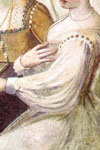
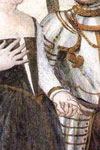

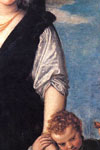
They look about 60 cm around at the most, so this is the measurement I'm going to use for my camicia sleeves. Below is the cutting plan I came up with.
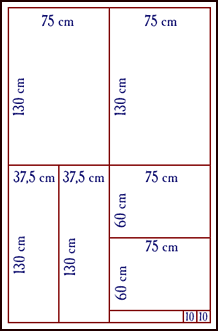
I am using the camicia diagram in Cut My Cote as a model. Bella has written to the Victoria and Albert Museum where the camicia is held and has posted their answer to her site (scroll to the bottom of the page). Kass McGann and Jennifer have also written how to sew one. My cutting plan is adapted to my dimensions.
This cutting plan uses 260 cm of 150 cm wide linen fabric. I will divide the fabric to half and use that as my “fabric width”.
Each body piece is full width wide and 130 cm long. Each side piece is 1/2 width wide and also 130 cm long. Sleeves are full width long and 60 cm wide. Each gusset is 10 x 10 cm square.
The gussets are so small because I have a short torso and 25 cm gores would reach my waist. The strip left over will be used for neck binding. Pretty efficient, eh? There won't be a scrap left.
These measurements include seam allowances. I will use flat felled seam and that won't decrease the measurements significantly.
09/07/04: The drawers
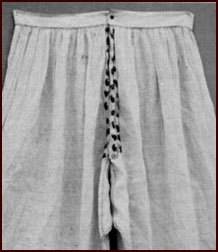
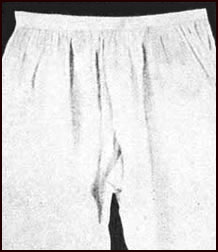
I looked at the pics I'd saved of drawers and noticed one thing. The following photos are of the same pair, the odd thing is that there is embroidery in one photo, but not in the other. Now, unless somebody carefully removed the embroidery, it is reasonable to assume that these two sides are different from each other.
On one side there is an embroidered opening with a button closure, on the other side there is no such thing. Fascinating, isn't it? I'd assume that the open side would be the back. Now the question remains: where does the opening end? At the beginning of the gussets in the front or higher? Or maybe it is open up to the waistband, hidden in the folds? What would be practical?
09/25/04: The drawers, documentation
Oonagh pointed out in an e-mail that I did not include any documentation about the drawers above. Oops! With all those questions in my mind I suppose I just forgot. Sorry about that. These drawers are dated to late 16th century Italy and are kept in Metropolitan Museum of Art, New York.
10/06/04: The camicia, cutting and sewing
Today is the day when it finally hit me: I'm going to Feast of St. Homobonus and I have nothing to wear! So I ironed 10 metres of linen and cut out my camicia. The camicia only took 2.6 m, but while I was ironing the fabric (it was too wrinkled to measure accurately) I figured I might as well iron all of it.
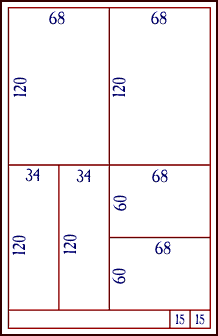
After feeling the full blast of the reality check it occurred to me to also check how long 130 cm really is. That, of course, resulted in some re-calculations — 130 cm is fine for long camicia if one measures from the shoulder, but it's way too long if one measures from armpit. I also checked how big a 10 cm square gusset would be (too small), 20 cm square (too big) and settled on 15 cm square, which is just right.
This diagram is the final diagram I used to cut out the camicia. The width numbers in this diagram are smaller because the fabric shrunk in wash. It shrunk substancially, I might add. I'm just glad I abused the heck out of it (90° wash, hottest setting on dryer) before it could pull the shrinking stunt on me after sewing.
I cut two 120 cm long pieces out of the fabric, and cut them in half. One of those I cut half lengthwise and another one widthwise. Then I cut a 15 cm wide strip from the whole width of the fabric. I cut two 15 cm wide pieces out of that and the rest is for bindings and such.
I will be using flat felled seam to sew it. I tried to find out what was used in Venice, but so far my search has been unsuccessful. The seam description #58 in Archaeological Sewing is from 11th century (Seam treatments on the Viborg shirt, Picture 4). Since there is nothing else and flat felled seam is a good, sturdy seam, I'll use that.
10/11/04: The camicia, still sewing
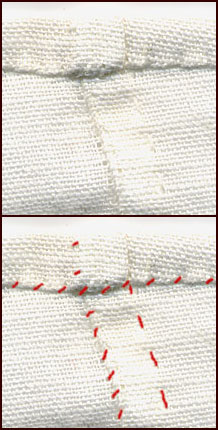
I was planning to have the camicia done by today, but that didn't happen. I only have to sew the neckline and then it's finished.
Instead here is a scan of the hem where hem meets the seam. The seam and hem are 5 mm wide so I scanned it large. Even now the stitches are almost impossible to see; I painted over the stitches on a copy to make them more visible.
This is the inside of the seam, only short pricks are visible on the outside.
I have also put up some hand sewing techniques where you can read more about stitches, seams, hems, etc.
10/27/04: The camicia, finished
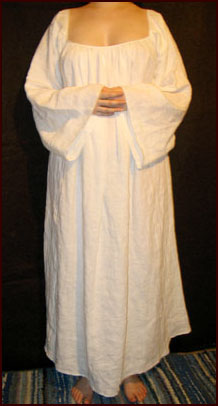
I had to put the camicia aside for a while to finish another project. The camicia neckline was finished before that, but I had to unpick some of it and resew. Namely, I had forgotten that the back should be narrower than the front. I hope that now, having written this down, I can remember better.
At first I had run gathering threads all around the sleeves too, but there was not enough fabric to make nice gathers. I went back to the Venetian paintings and noticed that the embroidered sleeves weren't gathered, but plain white sleeves were. Another lesson learned. Since I didn't want to make new sleeves, I decided to have gathers only at armpits and the rest of the sleeve smooth. It's not how it's supposed to be, but I take it as a lesson and do better next time.
The final measurements of the neckline are: front – 35 cm, back – 26 cm, sleeve head – 17 cm to the top fold.
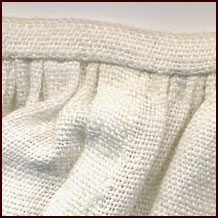
This picture is of the front of the neckline where the two body panels are joined.
To finish the neckline I first run two gathering threads 3 mm apart all around the neckline, then I took a 2 cm wide strip and backstitched it from the front to the neckine. These stitches go through the fabric, gathers and all. Then I folded the strip over to the backside and hemstitched it down. this time going through only the backside of the gathers, so nothing shows in the front. All this folding is made easier if you fold and crease the strip beforehand. It makes the first stitching easier too — the crease marks the stitch line.
11/10/04: The drawers
I will not make them for this event, there is not enough time.
To be continued in another diary.
11/11/04: The camicia seams
I found documentation for flat felled (running+overcast) seams in 16th century! Today while flipping through PoF and looking at sleeves I noticed that one cloak has flat felled seams, schematic #34 on page 97. Yay!








